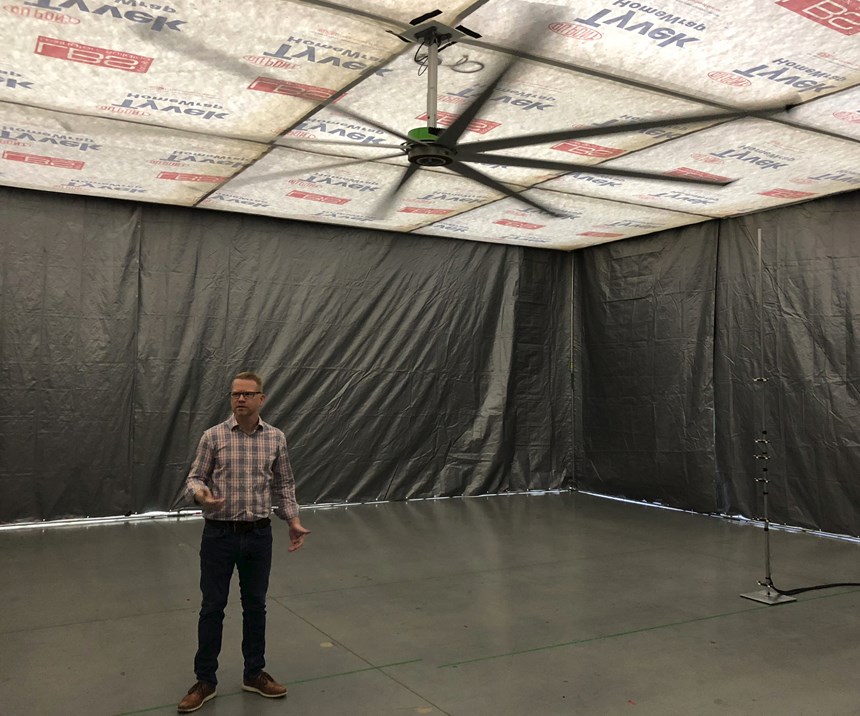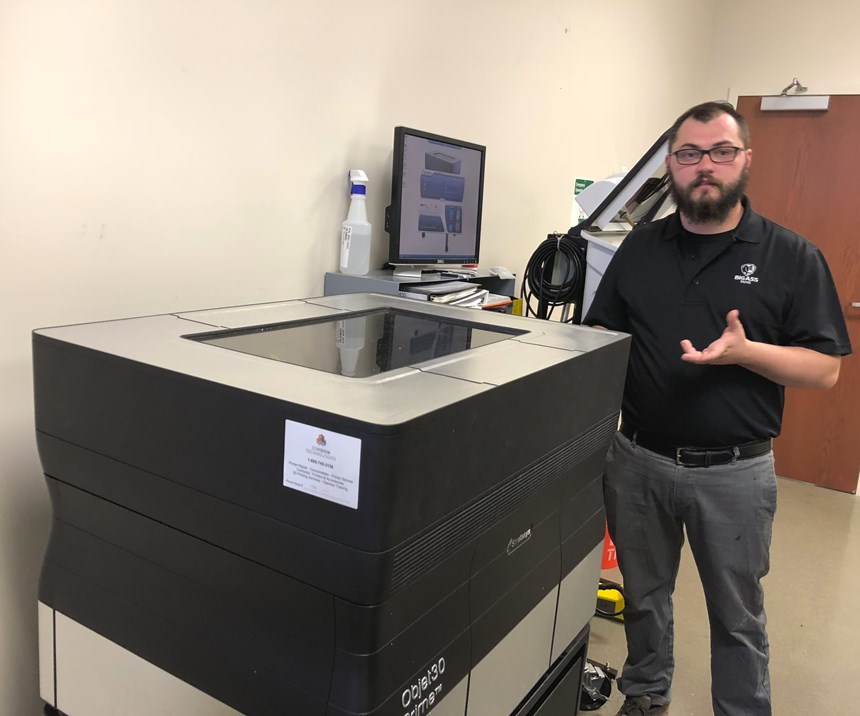3D Printing Prototypes: Iterate and Validate
3D printing is a common tool in product development, but for this fan manufacturer, it occupies two distinct steps in the process.
Share




We don’t tend to give much thought to the overhead fans turning above us in restaurants, airports, warehouses and machine shops, until they fail to work or become disruptive because of air movement or noise. To ensure that its fans are effective and efficient as well as quiet and safe, Big Ass Fans has invested heavily in studying their effects. The Lexington, Kentucky, company has an R&D facility devoted to the science of fans, with the capability to measure everything from cooling power to noise to electronics emissions.
The R&D work entails design iterations, and a lot of them. Some components of the fans are standard; for instance, the aluminum extrusions that form the airfoils generally only vary in their length from model to model within a series. However, the performance of these standard components can be affected by small features. Changing the size and shape of the winglets at the end of each blade, for example, can alter the air flow through the fan significantly. To design, test and prove out pieces like these, Big Ass Fans turns to 3D printing.
The company’s 3D printing capacity is held in two different locations on its Lexington campus: in the R&D facility as well as in a “tinker room” adjacent to the design department in the main headquarters. The reason to divide the capacity is not because of space constraints, but because of the two different functions that these printers serve. One set is primarily for design iteration; the other is for design validation.
First, Iterate
The R&D facility houses Big Ass Fans’ design iteration capacity: two Raise3D Pro2 Plus 3D printers. These filament-based systems are used for their spacious build volume (measuring 12 by 12 by 24 inches), speed, and compatibility with a range of materials, says Michael Smith, prototype design engineer. Open parameters and support for temperatures ranging to 300°C make it possible to print with a range of filaments from Raise3D and other providers, with the ability to adjust traction, speeds and extruder temperature for best results. Mr. Smith also finds this model reliable and trustworthy, even when running unattended (though he’s also installed Nest cameras for remote monitoring, just in case something should go wrong). Each printer puts in about 2,000 hours of work per year — equivalent to the hours worked by a full-time human employee.
These printers make fixtures, assembly aids, master molds for urethane casting, and occasionally end-use parts, but their primary use is to manufacture functional prototypes for product development, such as the winglets mentioned above. Whereas in the past the R&D shop would have needed to machine the parts from Delrin or outsource to another supplier, it can now quickly produce its own prototypes for testing. “When I need to iterate, I print,” Mr. Smith says.
For a new product, design engineers in the headquarters building first create and simulate a design using Ansys modeling software. That part file is then kicked over to the R&D facility for prototyping, iteration and testing. It’s at this point that Mr. Smith leverages his Raise3D printers to manufacture the prototypes, often creating several different variations within a few days. For a small part like a winglet, Mr. Smith might print as many as five design iterations (each one a set of six or eight winglets) in a single build. Then, the designs are rigorously tested so that the team can gather empirical data on their performance.
Testing facilities in the R&D lab range from a large room measuring 100 by 100 by 55 feet for testing a fan’s thrust without recirculating air, to smaller chambers (including some with adjustable ceiling height) that are more representative of a fan’s final installation environment.
As test configurations move through the facility, the R&D team is gathering information about the output of each one—the thrust of the fan, speed of the breeze produced, what temperature human occupants would feel, electrical emissions and more. Often the data gathered during this testing is used to inform further design iterations that can then be printed and tested. “There’s a lot of back and forth before we get to hard-tooling anything,” says Jay Fizer, R&D manager.
Then, Validate
The data captured during R&D testing is fed back into Ansys so that engineers can tweak the design before the final prototype is 3D printed on one of the tinker room printers. The tinker room houses a Fortus 370 and Objet 30 Prime 3D printer, both from Stratasys, for this purpose. These higher-end printers are more expensive to own and operate than those in the R&D lab, but they offer the precision and aesthetics desired for the final design validation.
Where R&D is concerned with printing successive iterations, engineering’s goal is to print designs already believed to be valid, Mr. Fizer says. And because of the earlier print and iterate cycle, they often are. The company has found that testing early with 3D printed prototypes has improved designs and helps expedite time to market for new products.
About the Author
Stephanie Hendrixson
Stephanie Hendrixson is senior editor with Additive Manufacturing magazine. This article first appeared on additivemanufacturing.media.
Related Content
In Moldmaking, Mantle Process Addresses Lead Time and Talent Pool
A new process delivered through what looks like a standard machining center promises to streamline machining of injection mold cores and cavities and even answer the declining availability of toolmakers.
Read MoreThe Cool Parts Showcase Seeks Innovative 3D Printed Parts
Do you solve problems with 3D printing? Enter your 3D printed parts in this contest from The Cool Parts Show.
Read MoreChuck Jaws Achieve 77% Weight Reduction Through 3D Printing
Alpha Precision Group (APG) has developed an innovative workholding design for faster spindle speeds through sinter-based additive manufacturing.
Read MoreHow to Meet Aerospace’s Material Challenges and More at IMTS
Succeeding in aerospace manufacturing requires high-performing processes paired with high-performance machine tools. IMTS can help you find both.
Read MoreRead Next
Metal AM System Revs Up Prototyping for Startup’s New Engine
The Desktop Metal Studio System demonstrates time and cost savings in prototyping and improving the parts for Lumenium’s IDAR engine.
Read More5 Rules of Thumb for Buying CNC Machine Tools
Use these tips to carefully plan your machine tool purchases and to avoid regretting your decision later.
Read MoreBuilding Out a Foundation for Student Machinists
Autodesk and Haas have teamed up to produce an introductory course for students that covers the basics of CAD, CAM and CNC while providing them with a portfolio part.
Read More
.jpg;width=70;height=70;mode=crop)
























.jpg;maxWidth=300;quality=90)











